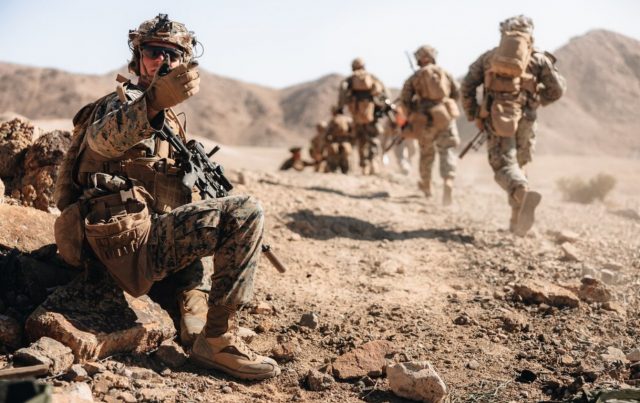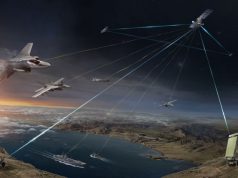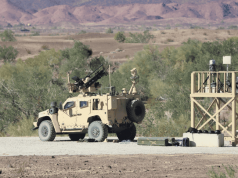
The Marine Littoral Regiment Training Exercise (MLR-TE) marked the first field training exercise featuring a MLR with all of its subordinate battalions integrated into a Marine Air-Ground Task Force (MAGTF) operating as a stand-in-force.
Aligned with the service’s Joint Warfighting Concept, the concept for stand-in forces will see marines positioned forward, shoulder-to-shoulder with partners, leveraging all-domain tools as the eyes and ears of the fleet and joint force.
Marines performing these operations will have the tasks of conducting reconnaissance and counter-reconnaissance for naval campaigns, including performing sea denial in designated areas in support of the campaign.
The 3rd Marine Division deployed its forward command element from Okinawa, Japan to Naval Amphibious Base Coronado where it functioned as an “intermediate headquarters” – a MAGTF headquarters providing command and control of the SiF, to include 3rd MLR and several other units, linking it to the US Navy fleet and other joint forces.
“This exercise represented an inflection point for us in that, up to this point, we have been focused on developing the MLR capabilities. We are now transitioning from just developing capabilities to having a capable unit that we are integrating into the stand-in force today,” said Maj. Gen. Jay Bargeron, 3rd Marine Division Commanding General.
The exercise consisted of three progressive phases: unit-level training, expeditionary advanced base operations (EABO), and an unscripted force-on-force evolution known as the MAGTF warfighting exercise.
Phase I consisted of high-intensity unit level training that challenged and sharpened various warfighting capabilities. The 3rd Littoral Combat Team conducted combined arms live-fire ranges, the 3rd Littoral Anti-Air Battalion took part in live air-defense scenarios, and the 3rd Littoral Logistics Battalion completed multifunctional logistics training and experimentation including employing the tactical resupply unmanned aircraft system.
After two weeks of training, the 3rd MLR transitioned into Phase II where it performed EABO across a contested and distributed maritime environment as part of a stand-in force. 3rd MLR utilized four expeditionary advanced bases to include a “sensing” EAB at Marine Corps Base Camp Pendleton providing airspace surveillance and control. Two “fires” EABs, one at Marine Corps Logistics Base Barstow and one at Camp Pendleton, enabled the 3rd MLR and 3rd Marine Division to coordinate and deliver lethal and non-lethal multi-domain fires in support of naval operations. The 3rd MLR headquarters signals intelligence and electronic warfare section operated from an EAB on San Clemente Island to identify adversary composition and disposition and to obfuscate friendly forces from adversary collection.
The 3rd MLR employed a combat operation center within Marine Corps Air Ground Combat Center Twentynine Palms where its Marines synthesized data generated from the EABs. To further enhance battlespace awareness, the 3rd MLR employed a reach-back fusion cell, outside the weapons engagement zone. The cell included various information, intelligence, and targeting capabilities.
MLR-TE provided us with an unprecedented opportunity to train as part of a stand-in-force,” said Col. Timothy S. Brady Jr., commanding officer of 3rd Marine Littoral Regiment. “We operated as an MLR, prosecuting targets as a multi-domain fighting force in support of the joint force and 3rd Marine Division.”
For Phase III, the 3rd Marine Division provided command and control for the MAGTF operating as a SiF successfully defending key maritime terrain against a near-peer adversary assault force composed of a reinforced 7th Marines. As an intermediate headquarters connected to the SiF to the Fleet, the division leveraged its forward position, sensing, and fires capabilities to expand the reach of naval and joint forces. Units making up the SiF included the 3rd MLR; 3rd Battalion, 5th Marines; a light armored reconnaissance company, an artillery battery, support from numerous Marine Corps aviation assets, and other elements.
“The Marines trained hard and performed extremely well,” said Brady. “We finished the exercise as a more capable, lethal, and ready warfighting force.”
The scenario required the MLR to apply adaptive decision-making, conduct assured command and control, execute a targeting cycle, perform logistics in a contested environment, and synchronize operations across all domains.
“The MLR is capable today, and it will be more capable tomorrow. From this point forward, we are integrating them into our operations,” said Bargeron.
3rd MLR and 3rd Marine Division will take their refined tactics, techniques, and procedures to exercise Balikatan 2023 where they will train alongside the Armed Forces of the Philippines to enhance its combined capabilities.


























